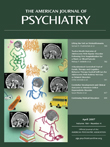Twelve-Month Outcome of Adolescents With Bipolar Disorder Following First Hospitalization for a Manic or Mixed Episode
Abstract
Objective: Although adolescent-onset bipolar disorder is associated with significant morbidity, there have been few prospective outcome studies of this population. The aim of this study was to examine the 12-month outcome of bipolar adolescents following an initial hospitalization for a manic or mixed episode. Method: Bipolar adolescents (N=71) were recruited during their first hospitalization for a manic or mixed episode and were evaluated using diagnostic, symptomatic, and functional assessments. Patients were also evaluated at 1, 4, 8, and 12 months after hospitalization to assess syndromic, symptomatic, and functional outcomes. Predictors of each type of outcome were identified. Results: Kaplan-Meier estimates of the cumulative probabilities of syndromal, symptomatic, and functional recovery and syndromic recurrence during the first 12 months following initial hospitalization were 0.86, 0.43, 0.41, and 0.54, respectively. Only 35% of bipolar adolescents reported full medication adherence. Individual predictors of poor syndromic recovery included co-occurring attention deficit hyperactivity disorder (ADHD), anxiety disorders, and disruptive behavior disorders as well as nonadherence to psychotropic medication and lower socioeconomic levels. Co-occurring alcohol use disorders, treatment with antidepressants, and the absence of psychotherapeutic intervention predicted syndromic recurrence. Boys were more than twice as likely as girls to experience symptomatic recovery. Conclusions: Most bipolar adolescents experienced syndromic recovery following their first hospitalization. However, rates of symptomatic and functional recoveries were much lower. Future studies examining effective pharmacological and nonpharmacological treatment strategies for bipolar youth with co-occurring disorders and investigating factors that contribute to the development of substance use disorders and treatment adherence in bipolar youth are necessary to improve outcome.



